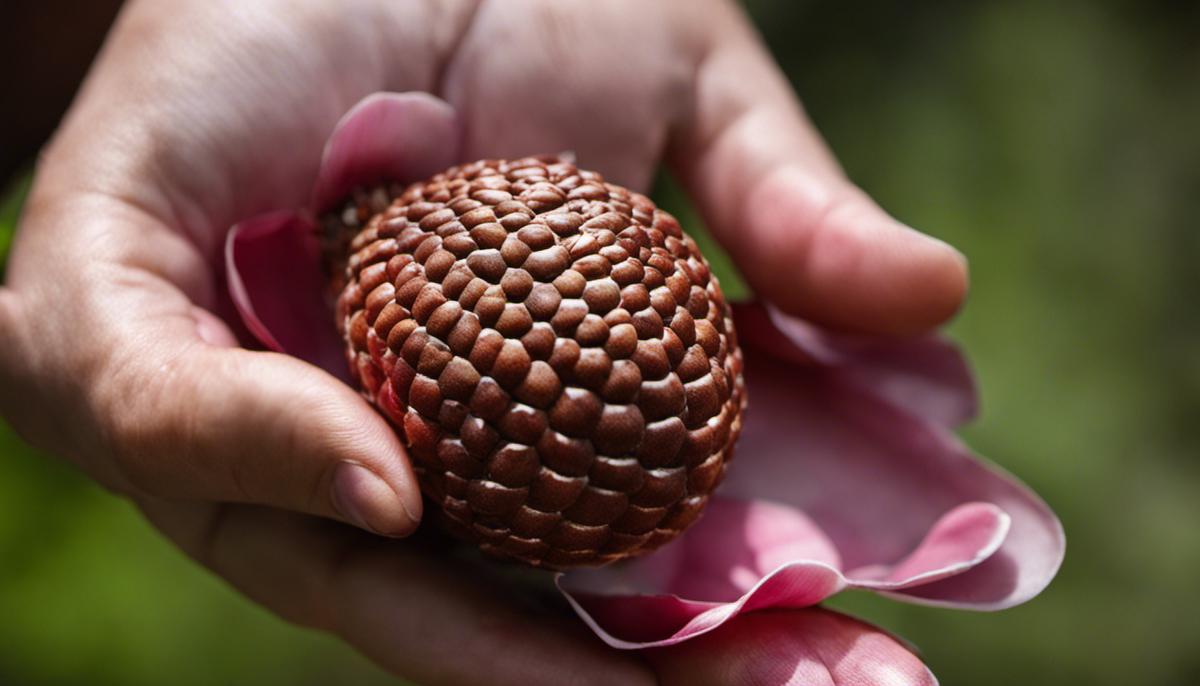Step-by-Step Guide to Growing A Magnolia Tree from Seed

The magnolia, with its distinctive flowers that burst into bloom in spring and summer, is a beloved fixture of many landscapes. However, cultivating these trees from seeds can seem a daunting prospect to those unfamiliar with the process. The act of growing a magnolia tree from a seed is an incredible journey that involves patience, care and knowledge. This text aims to educate you on three main aspects of it: the optimal moment and manner to collect magnolia seeds, the stratification process to successfully germinate them, and how to plant and take care of the seedlings post-germination.
Collecting Magnolia Seeds
The Wonderful World of Magnolia Seeds: The Ideal Collection Time and Method
Isn’t it delightful to engage in a hobby that lets you commune with nature? Gardening gives you that satisfaction and nothing else comes close. If magnolia plants have piqued your interest, and you are curious about collecting their seeds, there’s quite a bit you should know. This article provides meaningful insight into the perfect time and method for collecting magnolia seeds. Are you ready? Let’s dive in!
Magnolia trees captivate with their large, lustrous leaves and grandiose flowers, but these deciduous plants also offer up another treasure – their seeds. Although it might seem tricky to nail down, understanding the correct timing and process to gather magnolia seeds can yield a brilliant return. Imagine multiplying the beauty of these lovely trees, all from harvested seeds!
Primarily, timing is crucial when it comes to collecting seeds of any kind, magnolias included. Patience is key while waiting for the ideal time to harvest; rushing won’t do the job. After the flower has served its purpose, it’s time for the fruit to take the spotlight. By late summer or early fall, the magnolia tree bears fruits – these are the red, cone-like structures you see. Inside those fruits are the seeds, the objects of your pursuit.
The perfect time for collection is when the red fruits start to split open and reveal the seeds. If the seeds are still ensnared within the fruit cluster, you are slightly early. Wait until the seeds are clearly protruding from their cases. That’s the visual cue you are on-time for harvest. Anything beyond this stage indicates you’ve been tardy and the seeds are potentially overripe.
The best way to collect your booty is to use a clean, sharp pair of gardening shears. Cut off the entire fruit cluster, and place it in a paper bag. It’s essential to utilize paper over plastic because paper allows airflow, reducing the risk of mold or decay. After collecting, let the clusters sit in the paper bag for about a week. This rest period allows the fruit to dry completely and loosens the seeds further from their pods.
Following the waiting period, extraction is the next step. Wear gloves during the process because the seeds’ exterior can be slightly irritating to some individuals. Gently squeeze the dry fruit clusters, forcing the seeds out. It’s essential to remember that vigor is not needed here, as the seeds are delicate.
After the seeds have been wrested from the fruits, rinse them under lukewarm running water. Use a soft toothbrush or a similar tool to brush off the outer seed coating. Let the seeds dry completely on a paper towel. Once they’re dry, they’re ready for sowing or safe storage – awaiting the advent of spring for a new plant life to blossom.
Enjoy the process, fellow magnolia enthusiasts, as each seed holds the promise of a brand new, towering and majestic magnolia tree. Happy gardening!

Seed Stratification
Understanding Seed Stratification & Its Significance for Magnolia Seeds
Diving deeper into the fascinating world of magnolia growing, it’s impossible not to touch on one crucial phase: seed stratification. The term may seem intimidating, but it is actually a simple concept pivotal to successful magnolia propagation.
Seed stratification or cold stratification refers to the process of simulating the natural conditions that seeds must experience before germination can occur. It serves as preparatory stage for seeds and imitates the cold and moist conditions they undergo during winter. This cycle within Mother Nature’s schedule indicates to the seeds that it’s safe to start sprouting once the cold period concludes and warmer temperatures grace the land.
Why is this strategy significant for magnolia seeds? Well, to put it simply, seed stratification is akin to whispering secrets in the seeds’ ears, telling them, “It’s time for you to emerge!” Magnolia seeds, like many other hard-shelled seeds, need this encouragement to break dormancy.
This process tailored to magnolia seeds involves several precise steps. After cleaning and drying out the seeds, the stratification process involves packing the seeds in a mixture of peat moss and sand that provides cold, moist conditions akin to winter soil. It’s like providing the seeds with their own mini winter vacation!
These awaiting seeds are then to be stored in the refrigerator for approximately three months, maintaining temperatures between 33°F and 41°F. The point is not to freeze the seeds but to keep them in a chilled state, mimicking the ground during winter.
Throughout this chilly slumber, the seed’s outer shell softens and signals within the seed are sent to trigger the beginning of life – germination. Conversely, if these seeds were directly sown after the initial drying process, the results would likely be disappointing, as the unfavorable conditions may prevent the seeds from breaking dormancy and germinating.
A key hint in aiding this process: check on the seeds during their refrigerated rest. Make sure the peat moss and sand mixture is consistently damp, not dry or sogged. Also, look out for any signs of mildew, which is a frosty indicator that conditions are too wet. Adjustments might be needed in such cases.
Now that the staycation ends, it’s time for these seeds to make their grand debut. They are to be sown in well-draining soil and placed in a warm location, welcoming them back from their icy sleep. The journey, although patient, is rewarding, paving the way for these germinated seeds to blossom into charming, beloved magnolia trees.
The intricacies of seed stratification might seem daunting initially, but remember, every master was once a beginner! It’s all about understanding the reasons behind the process and embracing the patience that it warrants. Happy magnolia growing!

Planting and Caring for Magnolia Seedlings
Continuing with the magnolia seed journey, after the stratification process, comes the anticipation-filled moment of sowing the seeds and monitoring them as they sprout!
First things first, while planting, choose a location with well-draining soil. Magnolias don’t really like their roots drenched. A pH range between 5.5 and 6.5 is optimal. Remember, your seeds have been through a lot, and providing with the right soil is their first introduction to the world outside!
The soil should be fertile and rich in organic matter. If you’re planting them in pots, a combination of two parts potting mix to one part perlite works well. This combination helps maintain a balance between moisture retention and good drainage – crucial for those fragile seedlings.
Next, dig shallow holes that are approximately 3-4 inches deep and plant your germinated seeds, covering them lightly with soil. Gently pressing the soil down will ensure a good soil to seed contact.
Once the seeds are settled comfortably in their new home, they’ll need a good drink. Water the soil thoroughly but be mindful not to make it waterlogged. Maintaining evenly moist soil is key during this early development stage.
As the magnolia seedlings start their journey upwards, it’s important to provide them with suitable light conditions – they enjoy partial shade to full sun. However, in their initial growing stage, protecting them from intense afternoon sun can help prevent sun shock.
One of the crucial aspects of successfully raising magnolias from seedlings is monitoring and catering to their nutritional needs. A balanced, slow-release fertilizer that’s rich in nitrogen can give your seedlings the boost they need to grow robustly. However, remember to wait until the seedlings have at least four true leaves before introducing any type of fertilizer.
Another critical aspect is the need to protect the young plants from pests and diseases. Regular inspections for signs of fungus, root rot, or pest infestations will go a long way in safeguarding their health.
Finally, around their first birthday, it’s time for your seedling to move out, or rather, move up. When the seedlings are around a foot tall, it’s time to transplant them to their permanent location. Remember, the roots of your magnolias are shallow, and they absolutely hate being disturbed – so do this with utmost attention and gentleness.
A magnolia enthusiast knows that the journey doesn’t end here. It’s an ongoing process, from priming the tall tree for the seasons, to the exhilarating bloom of first flowers – patience, dedication and love are as necessary as sunlight and water. However, the joy that comes from witnessing a tiny seed grow into a magnificent magnolia tree – there’s nothing quite like that!

Mastering the art of growing a Magnolia tree from a seed, from understanding seed collection to perfecting seed care, can be an immensely rewarding endeavor. You’ll become deeply connected to your tree, watching it grow from a tiny seed into a majestic specimen. Additionally, you’ll contribute positively to the environment by adding another beautiful tree to the world. With the knowledge of when to collect magnolia seeds, how to stratify them, and the necessities for their subsequent care, you will be well on your way to boasting a stunning magnolia tree in your landscape.



